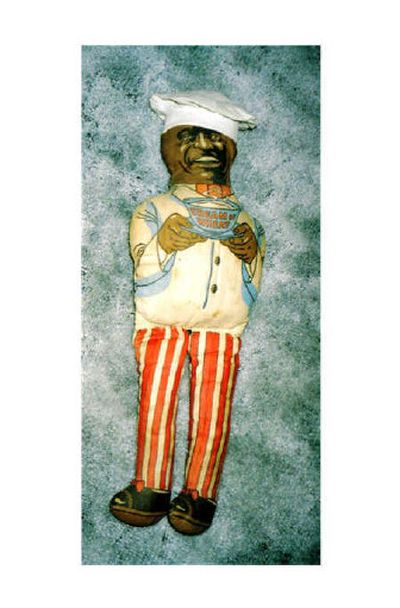THE COLLECTOR

Dear Collector,
I believe my mother sent off for this Cream of Wheat doll in the 1940s; what is he worth?
Rastus (from the Latin name Erastus meaning beloved) first became the symbol for this cereal in the 1890s, and may have been based on an actual restaurant chef. You have the right date for this cloth doll (made by any one of a half-dozen mills or print works). Now worth $60-$80, your advertising memorabilia initially cost a few box tops and 25 cents.
Dear Collector,
Would you tell me how much a vase made by “Lotus” is worth?
I would if you had sent along some pictures. I can tell you that Lotus was a brand name used in the 1950s by Roseville, the well-known Zanesville, Ohio pottery.
Dear Collector,
I’ve looked all over for information on Elizabeth Gardner Draper, an artist who lived in Rhode Island sometime in the early 1900s.
I did find some background on an Eliza Draper Gardiner (1871-1955), a woodcut artist born in Providence who was recognized for her landscape and still-life studies.
Dear Collector,
Can you identify the thing in this photo? My husband and I bought it for $1 at a yard sale a few weeks ago.
Not only could I not identify your “thing,” but the nine folks I showed it to couldn’t figure out which end of the photo was up. If you want to re-submit your question, include dimensions and a clear photo.
Dear Collector,
Is this check (copy enclosed) worth more than $5?
During the Civil War most Confederate States produced legal tender treasury notes, but Texas issued its own currency called Treasury Warrants. Your 1862 bill seems to have been canceled, recognizable by a hole punched in the center. If it’s real, and it may be just a reproduction, you paper note would be worth approximately $10.
Dear Collector,
What do you think this odd-looking gravy boat is worth?
I can see how you could confuse your invalid feeder with a gravy boat or even a creamer because the shapes on all three are similar, though their intended use differs. Made in Japan prior to WWII, this porcelain piece carries the Nippon “Rising Sun” mark, and has a current value of $40.
Dear Collector,
Will you help us identify the year this Seth Thomas clock was made? It came to us from my wife’s grandmother who may have been the original owner.
Late in the 19th century, Seth Thomas produced a series of spring-driven shelf clocks bearing place names (Austin, Albany, Detroit, Boston, etc.) which included your wood-case Pittsburgh. Today, this timepiece in working order is worth $300.
Dear Collector,
This Westinghouse radio reminds me of the art deco styling of the 1920s and ‘30s; is it that old?
Designed in the late 1950s, your model H-715T5 table top radio receives only FM, a signal modulation developed in 1933 by Edwin Armstrong. Based on research done in the ‘20s, FM broadcasting was superior to AM which was the standard until the 1950s.